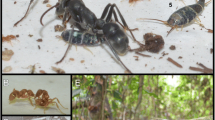Abstract
The ability to discriminate between nestmates and non-nestmates is an important prerequisite for the evolution of eusociality. Indeed, social insect workers are typically able to discriminate between nestmate and non-nestmate workers. Adult non-nestmate workers are readily detected and rejected from the colony. Whether social insects can discriminate between nestmate and non-nestmate brood, however, is less clear. Here, we show that workers of the leaf-cutting ant Acromyrmex echinatior discriminate between nestmate and non-nestmate brood, and among brood of different stages. Initially, non-nestmate brood is attacked, but it is adopted after a delay. Adoption could occur due to inefficiency of the recognition system, or it could be adaptive because it is an inexpensive way to increase the workforce. Our results suggest that brood adoption may occur accidentally. We also report how workers replace fungal hyphae on the brood’s surface before transporting the brood into their fungus garden.




Similar content being viewed by others
References
Bates D., Maechler M. and Dai B. 2008. Lme4: Linear mixed-effects models using S4 classes. R package version 0.999375-28. http://lme4.r-forge.r-project.org/
Bonavita-Cougourdan A., Clément J.L. and Lange C. 1987. Nestmate recognition: The role of cuticular hydrocarbons in the ant Camponotus vagus Scop. J. Entomol. Sci. 22: 1-10
Bot A.N.M. and Boomsma J.J. 1996. Variable metapleural gland size-allometries in Acromyrmex leafcutter ants (Hymenoptera: Formicidae). J. Kansas Entomol. Soc. 69: 375-383
Carlin N.F. and Hölldobler B. 1986. The kin recognition system of carpenter ants (Camponotus spp.): I. hierarchical cues in small colonies. Behav. Ecol. Sociobiol. 19: 123-134
Carlin N.F. and Schwartz P.H. 1989. Pre-imaginal experience and nestmate brood recognition in the carpenter ant, Camponotus floridanus. Anim. Behav. 38: 89-95
Currie C.R. 2001. A community of ants, fungi, and bacteria: a multilateral approach to studying symbiosis. Annu. Rev. Microbiol. 55: 357-380
d’Ettorre P. and Lenoir A. 2010. Nestmate recognition. In: Ant Ecology (Lach L., Parr C. and Abbott K., Eds), Oxford University Press, USA. pp 194-208
de Souza D.J., Della Lucia T.M.C., Errard C., Richard F. and Lima E.R. 2006. Behavioural and chemical studies of discrimination processes in the leaf-cutting ant Acromyrmex laticeps nigrosetorus (Forel, 1908). Braz. J. Biol. 66: 863-871
Febvay G., Mallet F. and Kermarrec A. 1984. Attractivité du couvain et comportement des ouvrières de la fourmi attine Acromyrmex octospinosus (Reich) (Hym. Form.). Actes Coll. Insectes Soc. 1: 79-86
Fénéron R. and Jaisson P. 1992. Nestmate-brood recognition among workers of different social status in Ectatomma tuberculatum Olivier (Formicidae, Ponerinae). Behav. Proc. 27: 54-52
Fénéron R. and Jaisson P. 1995. Ontogeny of nestmate brood recognition in a primitive ant, Ectatomma tubercalutum Olivier (Ponerinae). Anim. Behav. 50: 9-14
Hare J.F. and Alloway T.M. 1987. Early learning and brood discrimination in leptothoracine ants (Hymenoptera: Formicidae). Anim. Behav. 35: 1720-1724
Hefetz A. 2007. The evolution of hydrocarbon pheromone parsimony in ants (Hymenoptera: Formicidae) - interplay of colony odor uniformity and odor idiosyncrasy. A review. Myrmecol. News 10: 59-68
Hughes W.O.H., Eilenberg J. and Boomsma J.J. 2002. Trade-offs in group living: transmission and disease resistance in leaf-cutting ants. Proc. R. Soc. B 269: 1811-1819
Isingrini M., Lenoir A. and Jaisson P. 1985. Preimaginal learning as a basis of colony-brood recognition in the ant Cataglyphis cursor. Proc. Natl Acad. Sci. USA 82: 8545-8547
Krag K., Lundegaard R., Offenberg J., Nielsen M.G. and Wiwatwittaya D. 2010. Intercolony transplantation of Oecophylla smaragdina (Hymenoptera: Formicidae) larvae. J. Asia Pacific Entomol. 13: 97-100
Kronauer D.J.C., Gadau J. and Hölldobler B. 2003 Genetic evidence for intra- and interspecific slavery in honey ants (genus Myrmecocystus). Proc. R. Soc. Lond. B 270: 805-810
Lenoir A. 1981. Brood retrieving in the ant, Lasius niger L. Sociobiology 6: 153-178
Lenoir A. 1984. Brood-colony recognition in Cataglyphis cursor worker ants (Hymenoptera: Formicidae). Anim. Behav. 32: 942-944
Lenoir A., Fresneau D., Errard C. and Hefetz A. 1999. Individuality and colonial identity in ants. In: Information Processing in Social Insects (Detrain C., Deneubourg J.L. and Pasteels J., Eds), Birkhäuser Verlag, Basel. pp 219-237
Lopes J.F.S., Hughes W.O.H., Camargo R.S. and Forti L.C. 2005. Larval isolation and brood care in Acromyrmex leaf-cutting ants. Insect. Soc. 52: 333-338
Martin S.J., Takahashi J.-I., Ono M. and Drijfhout F.P. 2008. Is the social parasite Vespa dybowskii using chemical transparency to get her eggs accepted? J. Insect Physiol. 15: 700-707
Meudec M. 1978. Response to and transport of brood by workers of Tapinoma erraticum (Formicidae; Dolichoderinae) during nest disturbance. Behav. Proc. 3: 199-209
Morel L. and Vander Meer R.K. 1988 Do ant brood pheromones exist? Ann. Entomol. Soc. Am. 81: 705-710
Ottoni E.B. 2000. EthoLog 2.2: A tool for the transcription and timing of behavior observation sessions. Behav. Res. Methods Instrum. Comput. 32: 446-449
Poulsen M. and Boomsma J.J. 2005. Mutualistic fungi control crop diversity in fungus-growing ants. Science 307: 741-744
R Development Core Team 2010. R: A Language and Environment for Statistical Computing. R Foundation for Statistical Computing, Vienna, Austria. 1706 pp
Richard F., Poulsen M., Hefetz A., Errard C., Nash D.R. and Boomsma J.J. 2007. The origin of the chemical profiles of fungal symbionts and their significance for nestmate recognition in Acromyrmex leaf-cutting ants. Behav. Evol. Sociobiol. 61: 1637-1649
Rissing S.W. and Pollock G.B. 1987 Queen aggression, pleometrotic advantage and brood raiding in the ant Veromessor pergandei (Hymenoptera: Formicidae). Anim. Behav. 35: 975-981
Schönrogge K., Wardlaw J.C., Peters A.J., Everett S., Thomas J.A. and Elmes G.W. 2004. Changes in chemical signature and host specificity from larval retrieval to full social integration in the myrmecophilous butterfly Maculinea rebelli. J. Chem. Ecol. 30: 91-107
Soroker V., Vienne C. and Hefetz A. 1995. Hydrocarbon dynamics within and between nestmates in Cataglyphis niger (Hymenoptera: Formicidae). J. Chem. Ecol. 21: 365-378
Sumner S., Nash D.R. and Boomsma J.J. 2003 The adaptive significance of inquiline parasite workers. Proc. R. Soc. B 270: 1315-1322
van Zweden J.S. and d’Ettorre P. 2010. The role of hydrocarbons in nestmate recognition. In: Insect Hydrocarbons: Biology, Biochemistry and Chemical Ecology (Blomquist G.C. and Bagnères A.-G., Eds), Cambridge University Press, Cambridge, USA. pp 222-243
Viana A.M.M. 1996. La reconnaissance coloniale du couvain et du champignon chez la fourmi champignonniste Acromyrmex subterraneus subterraneus. Thesis University of Paris XIII.
Viana A.M.M., Frézard A., Malosse C., Della Lucia T.M.C., Errard C. and Lenoir A. 2001. Colonial recognition of fungus in the fungus-growing ant Acromyrmex subterraneus subterraneus (Hymenoptera: Formicidae). Chemoecology 11: 29-36
Weber N.A. 1966. Fungus-growing ants. Science 153: 587-604
Wheeler G.C. 1948. The larvae of the fungus growing ants. Am. Mid. Natr. 40: 664-689
Acknowledgments
This work was supported by the Marie Curie Excellence Grant CODICES (EXT-CT-2004-014202) and partly by a ‘‘Freia grant’’ from the Faculty of Science, University of Copenhagen, both assigned to PdE. BF was supported by the ERASMUS programme, and VN by the German Academic Exchange Service (DAAD). We thank the Smithsonian Tropical Research Institute (STRI) and the Autoridad Nacional del Ambiente (ANAM) for permission to work in Panama, and the Danish Natural Science Research Council for financial support. The authors also thank Hermógenes Fernández-Marín for fruitful discussions, all the members of the Centre for Social Evolution, University of Copenhagen, for a stimulating working environment, and Alain Lenoir and one anonymous referee for their helpful comments on the manuscript.
Author information
Authors and Affiliations
Corresponding author
Rights and permissions
About this article
Cite this article
Fouks, B., d’Ettorre, P. & Nehring, V. Brood adoption in the leaf-cutting ant Acromyrmex echinatior: adaptation or recognition noise?. Insect. Soc. 58, 479–485 (2011). https://doi.org/10.1007/s00040-011-0167-9
Received:
Revised:
Accepted:
Published:
Issue Date:
DOI: https://doi.org/10.1007/s00040-011-0167-9




